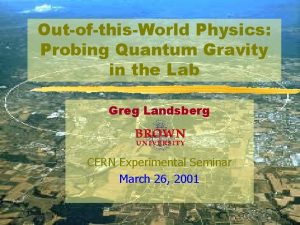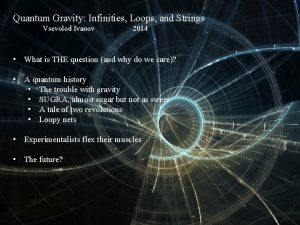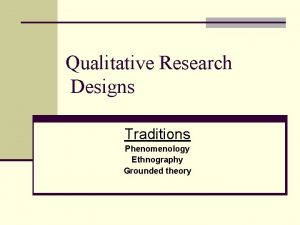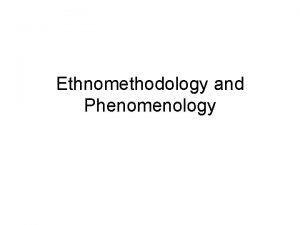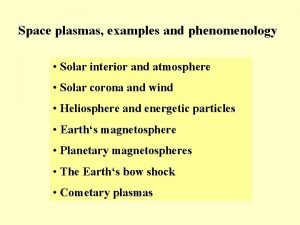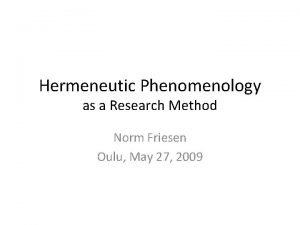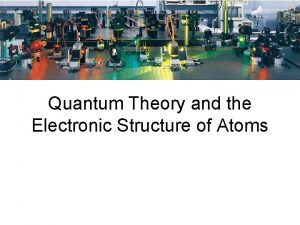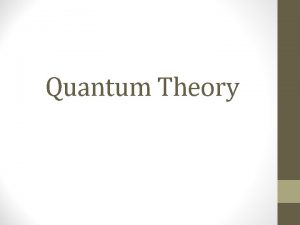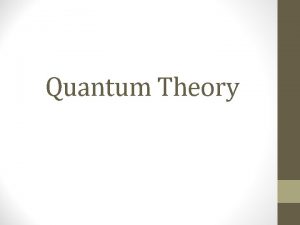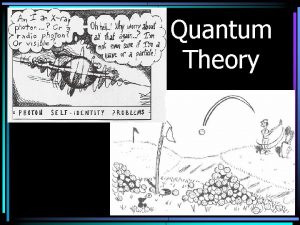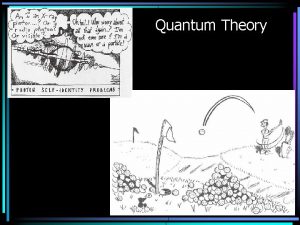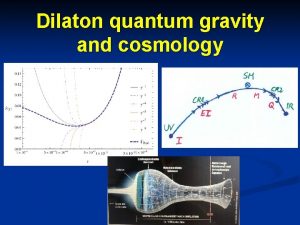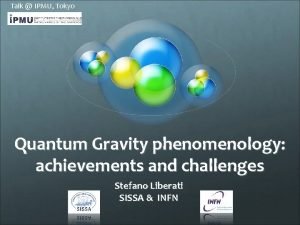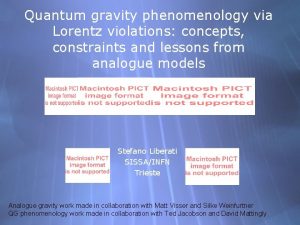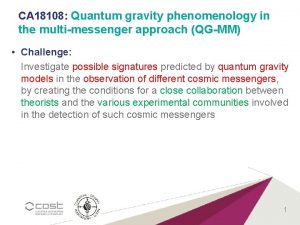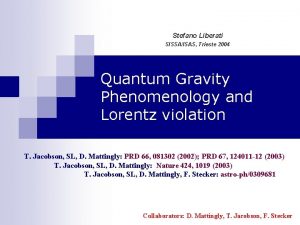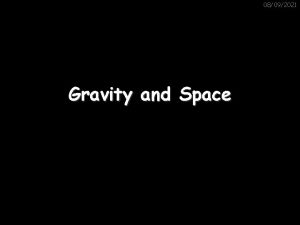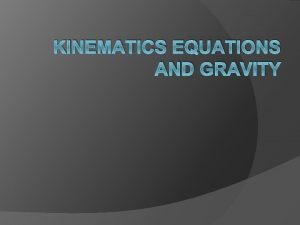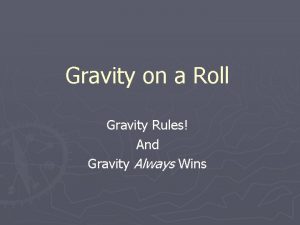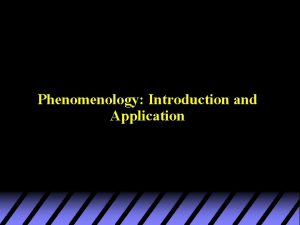DGP gravity Theory and Phenomenology From quantum to




















- Slides: 20

DGP gravity Theory and Phenomenology From quantum to Cosmos Fundamental Physics Research in Space Cédric Deffayet (APC & IAP, Paris) Q 2 C Warrenton 2006 1/ DGP model (in 5 D) or « brane induced gravity » 2/ Cosmology and phenomenology

Why being interested in this model ? One way to modify gravity at « large distances » … and get rid of dark energy ? Changing the dynamics of gravity ? Historical example the success/failure of both approaches: Le Verrier and • The discovery of Neptune • The non discovery of Vulcan… but that of General Relativity Dark matter or dark energy ?

1. The DGP model (or brane-induced gravity). Dvali, Gabadadze, Porrati, 2000 rd a nd l a t S de mo 5 D Einstein tensor 5 D Minkowski bulk space-time A « brane world » model: our 4 D space-time is a surface embedded in a large space-time Special equations of motion for gravity If equal to zero, standard, 4 D, Einstein equations (~ = c =1) Brane localization

Action principle for this ard d n l a t S de mo Usual 5 D brane world action Peculiar to DGP model A special hierarchy between M(5) and MP is required to render the model phenomenologically interesting • Brane localized kinetic term for the graviton • Will generically be induced by quantum corrections

DGP model Phenomenological interest A new way to modify gravity at large distance, with a new type of phenomenology … (Important to have such models, if only to disentangle what does and does not depend on the large distance dynamics of gravity in what we know about the Universe) Theoretical interest Consistent (? ) non linear massive gravity …

How does that work ? A scalar toy model for DGP 5 D D’Alembertian 4 D D’Alembertian Source for For a localized static source, one find the following response 5 D potential at large distances Transition 4 D potential at small distances

Back to the DGP model : • Newtonian potential on the brane behaves as 4 D behavior at small distances 5 D behavior at large distances • The crossover distance between the two regimes is given by This enables to get a “ 4 D looking” theory of gravity out of one which is not, without having to assume a compact (Kaluza. Klein) or “curved” (Randall-Sundrum) bulk. • But the tensorial structure of the graviton propagator is that of a massive graviton (gravity is mediated by a continuum of massive modes) Leads to the van Dam-Veltman-Zakharov discontinuity on Minkowski background!

The v. DVZ discontinuity as seen in Schwarzschild-type solution of « massive gravity » (DGP model, see thereafter!) +… +… Vainshtein ‘ 72 Wrong light bending! This coefficient equals +1 Introduces a new length scale r in Schwarschild solution in the problem below which the perturbation theory diverges! V For the sun: bigger than solar system!

So, what is going on at smaller distances? Vainshtein’s answer (1972): There exists an other perturbative expansion at smaller distances, reading: with This goes smoothly toward Schwarschild as m goes to zero No warranty that this solution can be matched with the other for large r! Boulware, Deser ‘ 72

2. Phenomenology of DGP model 2. 1 homogeneous cosmology a(t 0) a(t) The dynamics of the scale factor a(t) of our 4 D Universe (the brane) is governed by the modified Friedmann equation With C. D. ‘ 01 Analogous to standard (4 D) Friedmann equations for small Hubble radii Early cosmology as usual

Late time cosmology Depending on the sign of One virtue of DGP model: can get accelerated universe by large distance modification of gravity (C. D (‘ 01); C. D. , Dvali, Gabadaze (‘ 02)). Brane cosmology in 5 D Minkowski no R termfrom on Latebulk timewith deviation the brane (i. e. : solution to 5 D Einstein-Hilbert Action) standard Selfcosmology accelerating solution (asympotes de Sitter space even with zero matter energy density)

DGP self accelerating phase The brane (first) Friedmann equation Can be rewritten as with Phase diagram with = +1 Acts as a cosmological constant if = +1 Same number of parameter as CDM Maartens, Majerotto

Strictly speaking, only SN observations are depending solely on the background evolutions Vs. CDM Maartens, Majerotto ‘ 06 DGP CMB and more importantly Baryon oscillations should be re -computed taking into account the peculiarities of DGP gravity

2. 2 Back to the van Dam-Veltman-Zakharov discontinuity… • Exact cosmological solutions provide an explicit example of interpolation between theories with different tensor structure for the graviton propagator. C. D. , Gabadadze, Dvali, Vainshtein (2002) large rc small rc Solution of 4 D GR with cosmic fluid Solution of 5 D GR with a brane source Comes in support of a « Vainshtein mechanism » [non perturbative recovery of the « massless » solutions] at work in DGP…… Recently an other exact solution found by Kaloper for localized relativistic source showing the same recovery…. .

• Perturbative study of Schwarzschild type solutions of DGP model on a flat background space-time: Gruzinov, Porrati, Lue & Starkman, Tanaka Potential: Tensor structure: 4 D 4 D 4 D 5 D 5 D 5 D Tensorial structure of massive gravity Vainshtein radius for DGP model Related to strong self interaction of the brane bending sector C. D. , Gabadadze, Dvali, Vainshtein; Arkani-Hamed, Georgi Schwartz; Rubakov; Luty, Porrati, Rattazzi.

This has been generalized to cosmological backgrounds Lue, Starkman ’ 02 (see also Dvali, Gruzinov, Zaldarriaga ‘ 02) GR terms Correction depending on the cosmological phase For the Earth Universal perihelion precession Best prospect to detect this effect: lunar ranging experiments (BEPPI COLUMBO mission ? )

2. 3 Cosmological perturbations (linearized theory on a cosmological background) One can get effective (4 D) equations of motion which have the form (e. g. for matter on the brane with vanishing anisotropic stress) C. D. ‘ 02 Gravitationnal potentials Bulk « Weyl fluid » anistropic stress… Usual 4 D Einstein equations Has no local evolution equation This has been put to zero by various authors for Correct analysis done by Lue, Scoccimarro, Starkman; no good reasons (equivalent to « declare » that the model )has nostandard v. DVZ discontinuity !) LSS, Koyama, Maartens non growth of yields 8 < 0. 8 (at two sigma level)

2. 4 The dark side of DGP gravity… and Need for a good underlying quantum gravity construction Dvali, Gabadadze, Kolanovic, Nitti; Kiritsis, Tetradis, Tomaras; Antoniadis, Minasian, Vanhove; Kohlprath, Vanhove Meaning of this strong coupling scale, UV completion at a Luty, Porrati, Rattazzi; Dvali; scale even lower than Gabadadze; Nicolis, Rattazi; Rubakov Interesting issues related to comparison between linearized solution and spherically symmetric perturbative solutions Gabadadze, Iglesias

A Ghost in the self accelerating phase Luty, Porrati, Rattazi; Nicolis, Rattazzi; Koyama; Gorbunov, Koyama Sibiryakov; Charmousis, Kaloper, Gregory, Padilla. But appears at the cutoff of the scalar part of theory, also issues with the choice of boundary conditions C. D. Gabadadze, Iglesias in preparation Recent claim: no possible UV completion in a well-behaved theory ? Adams, Arkani-Hamed, Dubovsky, Nicolis, Rattazzi Not in DGP model, but at best in some limit where gravity has been decoupled !

Conclusions DGP gravity • Modifies gravity at large distances • Has a well defined action principle • Accelerates universe expansion with no c. c. and the same # of parameters as CDM • Can be distinguished from CDM • Exciting observables linked to the « Vainshtein mechanism » : gravity is (also) modified at distances smaller than cosmological • Interesting playground to investigate « massive gravity » (a candidate for a consistent theory of « massive gravity » ) More work needed to enlightened the dark side! IN PARTICULAR, ONE SHOULD KEEP IN MIND THE LOW CUTOFF OF THE SCALAR PART OF THEORY… AS A CONSEQUENCE, COMPARISONS WITH PRECISION DATA ARE TO BE CONSIDERED WITH SOME CAUTION !
 Transcendental phenomenology
Transcendental phenomenology Gravity for dummies and dummies for gravity equations
Gravity for dummies and dummies for gravity equations Similar image search
Similar image search Loop quantum gravity
Loop quantum gravity Classical physics
Classical physics Quantum physics vs mechanics
Quantum physics vs mechanics Phenomenology strengths and weaknesses
Phenomenology strengths and weaknesses Phenomenology and ethnography
Phenomenology and ethnography Ethnomethodology and phenomenology
Ethnomethodology and phenomenology Nenl
Nenl Phenomenology vs ethnography
Phenomenology vs ethnography Phenomenology vs case study
Phenomenology vs case study Phenomenology vs ethnography
Phenomenology vs ethnography The lived
The lived Sampling in qualitative research
Sampling in qualitative research Characteristics of a dystopian society
Characteristics of a dystopian society What is the strength of grounded theory
What is the strength of grounded theory Hermeneutic phenomenology
Hermeneutic phenomenology Lowest allowable energy state of an atom
Lowest allowable energy state of an atom Electrons in atoms section 2 quantum theory and the atom
Electrons in atoms section 2 quantum theory and the atom Quantum theory and the electronic structure of atoms
Quantum theory and the electronic structure of atoms


